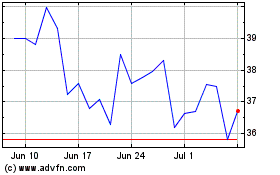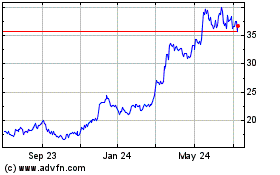FAA to Propose Safety Fixes for Certain Boeing and Embraer Jets
November 29 2015 - 8:40PM
Dow Jones News
U.S. aviation regulators on Monday will propose mandatory
inspections and, if necessary, replacement of suspect parts on
nearly 1,600 jetliners to prevent potentially catastrophic
failures.
The pair of proposed Federal Aviation Administration safety
directives, related to certain Boeing Co. and Embraer SA jets and
slated to be formally published Monday in the Federal Register, are
unusual because they are each intended to counter a single defect
that can result in such a serious problem.
Most essential systems on commercial jets have backups, so a
single-point failure or malfunction can't cause a crash. In both of
the documents, however, the FAA says a single defective type of
component has the potential to immediately end safe flight. The
agency isn't ordering immediate fixes, however, which means
officials have determined the hazards aren't imminent and don't
require emergency action.
The FAA is moving to require U.S. operators of certain versions
of the popular Boeing 737 model to check for possible corrosion of
attachments for the horizontal stabilizer, part of the tail
section.
According to the agency, because of a manufacturing mistake that
left some parts without the necessary protective finish to guard
against corrosion, certain bushings can crack. That can result in
structural failure and possibly "departure of the horizontal
stabilizer from the airplane," according to the FAA, "which can
lead to loss of continued safe flight."
The proposed directive covers some 1,400 of the 737 models,
beginning with the 737-600 version and a number of later
variants.
The FAA document indicates the problem was discovered after
production of the affected stabilizers and the agency wants
airlines to detect and correct possible structural cracks.
A separate proposed mandate, applying to airliners manufactured
by Brazil's Embraer, the world's third-largest plane maker behind
Boeing and Airbus Group SE, covers a total of 197 twin-engine
Embraer 170 and 190 regional jet models.
The FAA has determined that certain defective valves, prone to
cracking, could "result in dual engine in-flight shutdown" on the
affected aircraft. The agency envisions giving U.S. carriers three
months to comply with some of the mandates.
Both manufacturers raised the safety issues previously in
separate safety bulletins. Last year Brazilian air-safety
regulators mandated some of the fixes, but didn't include certain
170 models in their order.
Pending public comment, the FAA now wants to make all of the
previous voluntary fixes mandatory for U.S. operators while
expanding beyond Brazil's directive.
Foreign airlines and regulators typically follow the FAA's
lead.
The agency's proposals don't mention any accidents or incidents
stemming from the manufacturing defects.
Write to Andy Pasztor at andy.pasztor@wsj.com
Subscribe to WSJ: http://online.wsj.com?mod=djnwires
(END) Dow Jones Newswires
November 29, 2015 20:25 ET (01:25 GMT)
Copyright (c) 2015 Dow Jones & Company, Inc.
EMBRAER ON (BOV:EMBR3)
Historical Stock Chart
From Mar 2024 to Apr 2024

EMBRAER ON (BOV:EMBR3)
Historical Stock Chart
From Apr 2023 to Apr 2024
